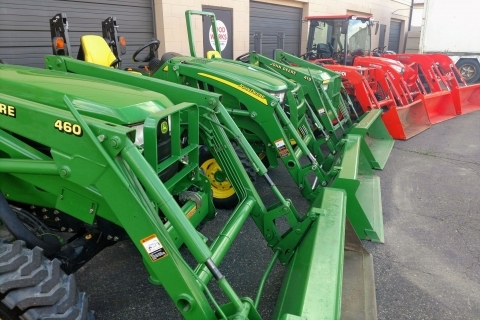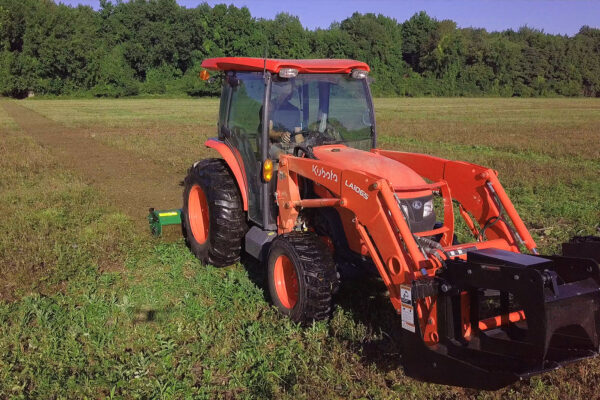John Deere versus Kubota. Which is the better tractor? It’s an age old debate that my customers ask me on a regular basis. Which do I prefer and why? Well, I thought I’d take the time to go through five reasons why I think John Deere is better than Kubota. No, I’m not a John Deere die hard as I really appreciate some of the features that Kubota has to offer. So much so, that I’m creating another video and accompanying article on five areas that Kubota is better than John Deere. If you haven’t watched the John Deere Is Better Than Kubota video, then click here to watch!
The simple answer is that there’s no clear winner. I sell both used John Deere and Kubota tractors because of the proven reliability, parts availability, and plethora of dealer locations around the country to provide support. Couple this with excellent resale value and it’s really hard to go wrong either way. Also, I listen to my customers and what they are looking for are John Deere and Kubota. Nothing else comes close. Rule #1 of business is to give the customer what they want.
SHOP GOOD WORKS TRACTORS INVENTORY! WE CAN SHIP ANYWHERE IN THE CONTINENTAL US!
So, let’s get into the five areas where John Deere beats Kubota in the head to head competition. The first reason is that somehow plastic has trumped metal. I’m not talking about the cheap plastic panels found on garden tractors. The polymer panels found on John Deere sub-compact and compact tractors are light years ahead of metal. For anyone in the automotive or aerospace engineering world, you’re probably familiar with high strength plastics and their benefits. These aren’t being used in structural locations, but rather trim pieces such as hoods and fenders.
I have dozens and dozens of John Deere’s and Kubota’s come through every year and it’s always an enjoyable, but rare, sight to see an older Kubota that still shines up and is in great cosmetic shape. Unfortunately, their metal panels are simply unforgiving to the slightest mistake. They rust, they ding, they dent, and they fade! Well plastic doesn’t rust. You hit it with a hammer and it simply flexes and rebounds. Yes, you can gouge chunks out of plastic or even break it. However, if it’s that violent of an impact, then you can bet there will be damage to the steel panels as well. Lastly, they hold their color much better than painted Kubota panels. No amount of buffing can take that pink hue out of a faded Kubota paint job. A decent buff and wax will save even the worst of cases on John Deere.
Reason #2 is the hydrostatic pedal configuration. John Deere has side by side pedals for forward and reverse on the right side of the operator station floorboard. The brake pedal is found on the left side of the floorboard. Kubota has something called a treadle pedal which uses a pedal by your toe to go forward and another pedal to push with your heel to go in reverse. This is found on the right side of the operation station floorboard as well. Not only is the rear pedal located such that it utilizes an good chunk of valuable floor space, it is also awkward to try and control pressure with your heel. Additionally, Kubota has decided to locate their brake pedal directly above the “go forward” hydrostatic pedal. If you find yourself in an emergency situation where immediate braking is needed, this could quickly cause a catastrophe by accidentally pressing the wrong pedal or both at the same time.
The third reason that John Deere is better than Kubota is the integrated parking stand that John Deere offers which Kubota does not. Wait, are you thinking that I’m wrong because Kubota does offer a built-in parking stand? Well, they do have a “quick park” loader which requires hopping off the tractor, moving the legs from the stored to stand position, hopping back on the tractor to work the loader joystick, hopping back off to remove one retaining bolt, walking around to the other side to remove the second retaining bolt, then hopping back on the tractor to work the joystick to park the loader.
Whew, that took almost an entire paragraph to explain. With John Deere, you use the loader joystick to put down pressure on the bucket, then flip up each spring loaded bracket from the operation station, then work the joystick to park the loader. Notice that I didn’t mention fooling around with the parking stand? That’s because John Deere has integrated it in a way that allows the stand to move into position as the hydraulics are moved when parking the loader. It is vastly superior and there’s simply no other way to put it. With either system, you must disconnect your hydraulics afterwards. Watch a video on how a John Deere loader is installed by clicking here.
Reason #4 that John Deere wins the debate is that all but one loader (model D120, watch video here) come standard with a quick attach bucket. A quick attach bucket is needed if you want to utilize your loader for something besides a bucket. Attachments such as pallet forks, bale spear, snow pusher, grapple, and snow blade can all be mounted to the end of the loader arms. Many, many Kubota front end loaders come standard with a pin-on bucket which is not quick attach. This means you cannot quickly add those other attachments to your loader. Kubota does offer an option to upgrade to a skid steer quick attach carrier which is very nice, it will just cost you more.
Lastly, with all the tractors I’ve bought and sold over the years, I’ve found that John Deere holds their value better than any other brand. This includes Kubota as well. Some will say that a used John Deere costs more than a comparable used Kubota because it was a higher price when new. Well, I’m taking that into consideration and saying that John Deere’s depreciate the least amount from their new price over the years. I will say that this could vary from market to market as tractor prices are simply not the same in every part of the country.
I don’t list all of the reasons of why John Deere is better than Kubota simply to bash the competition. I believe both John Deere and Kubota build quality tractors and a prospective buyer is going to be a happy camper with either choice. It’s a very common question to ask and one that deserves an honest answer. I don’t hold any bias against John Deere or Kubota. John Deere has their short comings as well and you’ll have a chance to see where Kubota shines in another follow up video and article. So, thanks for sticking around to read and hopefully this helps you with a decision down the road.


